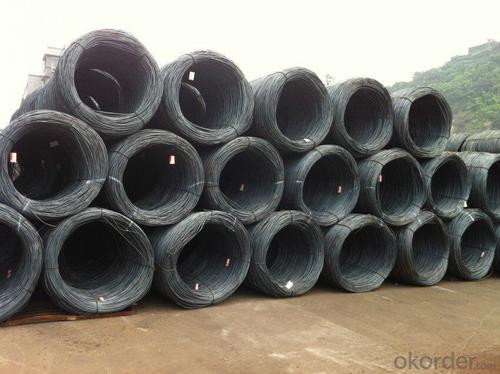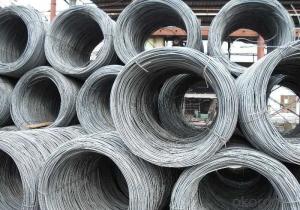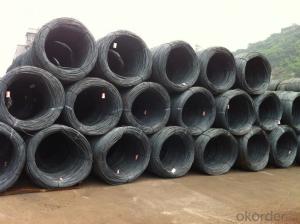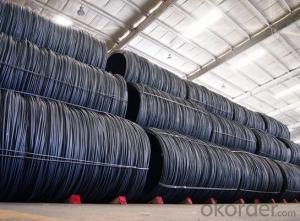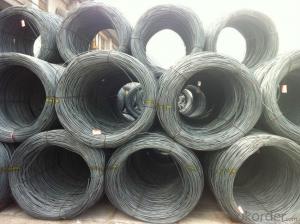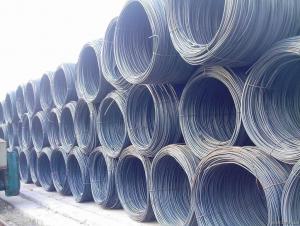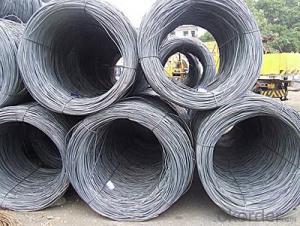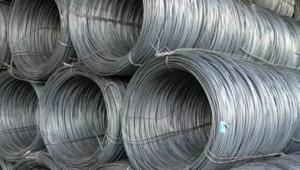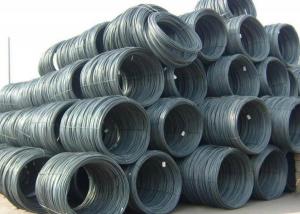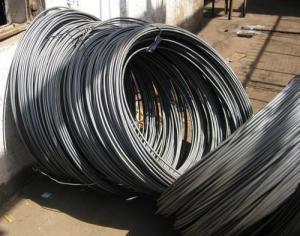Supply 6.5mm steel wire rod in coils with grade A quality
- Loading Port:
- Tianjin
- Payment Terms:
- TT OR LC
- Min Order Qty:
- 25 m.t.
- Supply Capability:
- 500000 m.t./month
OKorder Service Pledge
OKorder Financial Service
You Might Also Like
Specification
Steel Grade: Q195/235, SAE1006-1018B Standard: ASTM, GB
Diameter: 5.5mm, 6.5mm, 7mm,8mm,9mm,10mm,12mm,14mm
Type: Drawn Wire Alloy or Not: Alloy Brand Name: HSKY
Technique: Hot Rolled Place of Origin: China Mainland
Chemical Composition:(Please kindly find our chemistry of our material based on SAE1006B and SAE1008B as below for your information)
High carbon/Low carbon/common carbon Steel wire rod | With boron for rebate tax |
Grade | SAE1006B SAE1008B SAE1018B |
Package | In coil ,in bundle, |
Coil weight | about 2000kg-3000kgs |
Size: | 5.5mm 6.5mm 8mm 10mm 12mm 14mm 16mm |
Types | High Carbon ,Low carbon ,Common carbon |
Exported Country | South Korea,Vietnam,Indonesia,Myanmar,Philippines and Afrca,Ect |
Delivery term: | within 30 days after receive the LC |
Payment Term: | LC at sight ,LC 30-120 days after B/L date, TT payment |
The Standard of Physical Properties:
Grade | Chemical Composition(%) | |||||
C | Mn | Si | S | P | Cr | |
SAE1006 | 0.03~O.07 | ≤0.32 | ≤0.30 | ≤0.045 | ≤0.040 | >0.30 |
Mechanical properties | ||||||
Yield strength(N/mm2) | Tensile strength(N/mm2) | Elongation(%) | ||||
250-280 | 350-380 | ≥32 | ||||
Grade | Chemical Composition(%) | |||||
C | Mn | Si | S | P | Cr | |
SAE1008 | 0.10max | 0.3~O.50 | 0.15max | 0.050max | 0.040 max | 0.30 min |
Mechanical properties | ||||||
Yield strength(N/mm2) | Tensile strength(N/mm2) | Elongation(%) | ||||
≥195 | 315-430 | ≥30 | ||||
Usage and Applications of Steel Wire Rod in Coil:
After hot-rolled the products shaped into coil and delivery as finished product, including round, square, rectangular, hexagonal and so on, Since most of the products are round, it is generally called wire rod. Steel wire rod is widely used in construction and manufacturing. Steel wire rod is mainly used for reinforcement of reinforced concrete and welded structure or reprocessed (roberts, nail etc) materials, especially used to produce wire drawing, welding electrode, nails,spring, electronic, precise machinery parts and so on.
Packaging & Delivery of Steel Wire Rod in Coil:
Packaging Detail: products are packed in coil and then shipped by container or bulk vessel
Each coil weight: 2-3MT
Delivery Detail: within 45 days after received deposit or LC.
Label: to be specified by customer, generally, each bundle has 1-2 labels
Trade terms: CFR, CIF

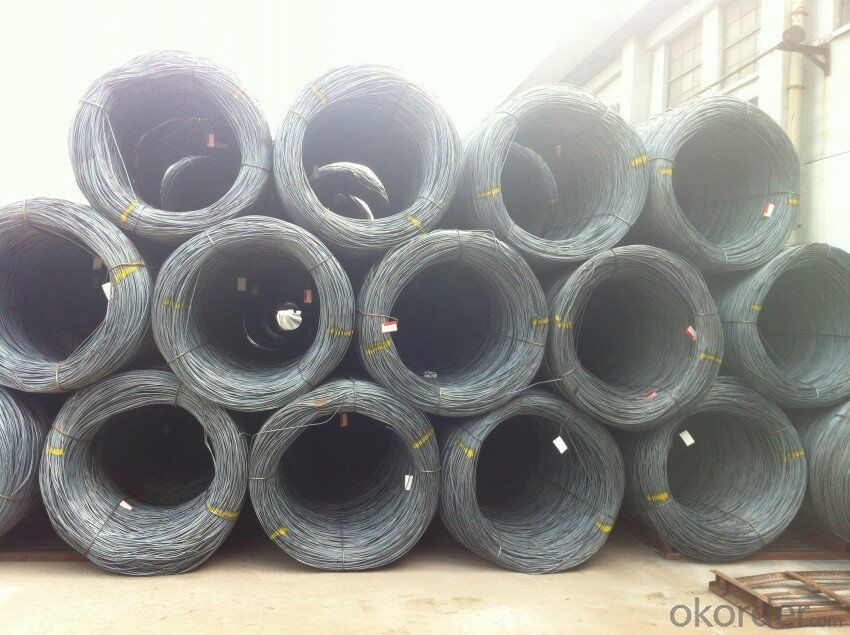
- Q: How are steel wire rods used in the manufacturing of surgical instruments?
- Steel wire rods are commonly used in the manufacturing of surgical instruments due to their high strength and durability. These rods are first cut into desired lengths and then shaped into various instrument components such as handles, shafts, or cutting edges. The steel wire rods serve as the base material, providing the necessary strength and integrity required for surgical instruments to withstand the rigorous demands of medical procedures.
- Q: What are the main factors influencing the choice of steel wire rod order warranty claims process?
- The main factors influencing the choice of steel wire rod order warranty claims process include the quality of the wire rod, the reputation and track record of the supplier, the terms and conditions of the warranty, the cost and convenience of the claims process, and the level of customer support provided by the supplier.
- Q: How is steel wire rod used in the manufacturing of mattress springs?
- Steel wire rod is used in the manufacturing of mattress springs as it provides the necessary strength and durability required for the springs to support the weight of the mattress and its occupants. The wire rod is typically coiled and then shaped into the desired spring form, ensuring that the mattress provides adequate support and comfort to the user.
- Q: What are the different types of steel wire rod finishes for aesthetic purposes?
- There are several different types of steel wire rod finishes that can be used for aesthetic purposes. Some common finishes include polished, brushed, matte, and textured. These finishes can enhance the appearance of the steel wire rod and provide a desired visual effect for various applications.
- Q: How are steel wire rods used in the manufacturing of fishing nets?
- Steel wire rods are an essential component in the manufacturing of fishing nets. These rods serve as the skeletal structure of the net, providing strength and durability to withstand the harsh conditions of fishing. To begin the manufacturing process, the steel wire rods are first straightened and cut into various lengths, depending on the desired size of the net. These rods are then woven or knotted together to form the net's framework. The tight weaving ensures that the net is sturdy enough to withstand the pressure of catching fish and resist breaking or tearing. The steel wire rods used in fishing nets are specifically chosen for their high tensile strength and corrosion resistance. This makes them suitable for enduring the corrosive effects of saltwater, as fishing nets are primarily used in marine environments. Additionally, the steel wire rods are often coated with a protective layer, such as zinc or PVC, to further enhance their durability and prevent rusting. Furthermore, the flexibility of steel wire rods allows the fishing net to adapt to different shapes and sizes. This flexibility is crucial as it enables the net to conform to the contours of the water, maximizing its effectiveness in capturing fish. In conclusion, steel wire rods play a vital role in the manufacturing of fishing nets, providing the necessary strength, durability, and flexibility. Their high tensile strength and corrosion resistance make them an ideal choice for withstanding the harsh conditions of fishing. Without these steel wire rods, the manufacturing of fishing nets would not be possible, and the fishing industry would be greatly impacted.
- Q: What are the common production processes for alloy steel wire rod?
- The common production processes for alloy steel wire rod include melting and refining the raw materials, continuous casting to form a solid billet, hot rolling the billet into wire rod, followed by cooling, surface treatment, and final inspection and packaging.
- Q: What are the main applications of steel wire rod?
- The main applications of steel wire rod include construction materials, automotive parts, electrical cables, wire mesh, fencing, nails, screws, and various other industrial and commercial products where high tensile strength and durability are required.
- Q: How is steel wire rod used in the manufacturing of nails and screws?
- Steel wire rod is used in the manufacturing of nails and screws as it serves as the primary raw material. The wire rod is first drawn through a series of dies to obtain the desired diameter and shape. This process strengthens the wire, making it suitable for holding nails and screws together. The resulting wire is then cut into specific lengths and shaped into nails or screws using specialized machinery. The high strength and durability of steel wire rod ensure that the final products are sturdy and reliable for various applications.
- Q: What are the different types of steel wire rod coatings used for improved heat resistance?
- There are several types of steel wire rod coatings used for improved heat resistance. Some common coatings include zinc-based coatings, aluminum-based coatings, and ceramic coatings. These coatings provide a protective barrier that enhances the wire rod's ability to withstand high temperatures and prevent oxidation or corrosion. Additionally, these coatings can also improve the wire rod's overall durability and longevity in high-temperature environments.
- Q: What are the main factors affecting the market trends of steel wire rod?
- The main factors affecting the market trends of steel wire rod include demand from industries such as construction, automotive, and manufacturing, global economic conditions, raw material prices and availability, technological advancements, government policies and regulations, and competition within the industry.
Send your message to us
Supply 6.5mm steel wire rod in coils with grade A quality
- Loading Port:
- Tianjin
- Payment Terms:
- TT OR LC
- Min Order Qty:
- 25 m.t.
- Supply Capability:
- 500000 m.t./month
OKorder Service Pledge
OKorder Financial Service
Similar products
Hot products
Hot Searches
Related keywords



